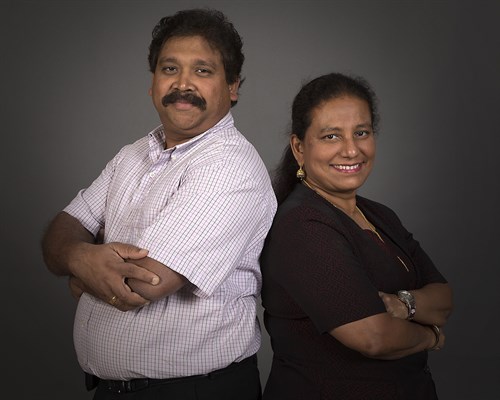Same Journey, Different Directions
Dr. Joe Arosh and Dr. Sakhila Banu share many things. They work in the same department—the Department of Veterinary Integrative Biosciences (VIBS) at the College of Veterinary Medicine & Biomedical Sciences (CVM). Their offices are in the same hall. They share a marriage and a love for their twin daughters, Jerusha and Elsha Arosh. And, although they both conduct research on female reproduction, their research interests are unique from each other and within their respective fields.

Arosh is one of the leading researchers on endometriosis, a condition characterized by pelvic pain and infertility in women of childbearing age. Banu is the only researcher in the United States focused on the effects of hexavalent chromium, a heavy metal toxicant in the environment, on ovarian development.
Arosh and Banu’s story began well before they came to the CVM. The couple met in India, their home country, and worked on a short-term collaborative project in large animal endocrinology between the University of Madras and Madras Veterinary College in Chennai (Madras), India. They both studied at the Centre de Recherché en Biologie de la Reproduction at Laval University in Quebec, Canada. They continued their research in the same lab and married in 2002. This journey ultimately led them to Texas A&M University.
In 2004 and 2005, Arosh and Banu accepted jobs as faculty at the CVM, respectively. This became a turning point and opened the door for each of them to become leaders and innovators in their respective research areas.
Arosh: Endometriosis and Finding Relief
Arosh began his career as a veterinarian and earned his B.V.Sc.—the equivalent of a DVM—from Madras Veterinary College in India. For five years he practiced as a mixed-practice veterinarian, seeing mostly dogs and ruminants. However, Arosh’s interest in reproduction inspired him to pursue research, starting with a master’s in obstetrics and gynecology (India) and a Ph.D. in reproductive endocrinology (Canada).
Today, Arosh researches prostaglandins and the uterus using ruminants as a model.
Prostaglandins are critical hormones required for estrous cycle and establishment of pregnancy in cows and sheep and other ruminants. “Prostaglandins are central inflammatory mediators,” Arosh said. “They play a major role in inflammation of several diseases. They can have a beneficial role in reproductive biology, but they can also have very adverse effects. Prostaglandin pathways have been targeted by drugs like NSAIDS—Aspirin, Ibuprofen, Tylenol—for more than 100 years to decrease pain and inflammation in human and animal health and diseases.”
Pregnancy in ruminants is an essential part of the food and fiber industries, such as the dairy and beef industries, and issues with pregnancies in ruminants can cause economic losses. Therefore, Arosh is looking to understand the mechanisms behind prostaglandins and the uterus and improving reproductive efficiency in ruminants by developing new therapies.
Arosh’s research goes beyond veterinary medicine. He has developed an interest in endometriosis, a disorder caused by growth of the uterine lining in places other than the uterus—such as the abdomen—and the body painfully attempting to shed that lining. The condition is estimated to affect between five and 10 percent of women who are of reproductive age and is the most common cause of hysterectomies in the United States. “When I learned that endometriosis is an inflammatory disease and affects only menstruating women, I knew that prostaglandins should play a major role in this disease,” Arosh said.
Currently, therapies for endometriosis are limited. Steroids may help ease the pain in the short term, but do not provide lasting benefits for pain or fertility. “People worked with steroids for the last 100 years,” Arosh said. Unfortunately, targeting estrogen is undesirable. Because estrogen is an important hormone women need for their healthy reproductive life, it’s time for researchers to think differently on non-estrogen targets to preserve fertility and reduce pain in endometriosis women.”
Surgery is also an option. “The therapies we have now include removing the uterus or the ovaries, but we will not be able to preserve the fertility,” Arosh said. “The affected women can get some relief from the pain for about seven years. After that, the pain does come back.”
Seeing the need for something better, Arosh began exploring alternative treatment options, mainly nonsteroidal therapy. He started looking for something more effective with less adverse effects on fertility. By understanding the biochemical mechanism of prostaglandins in endometriosis, he believes that targeting prostaglandin pathways or signaling may emerge as novel non-steroidal therapy for endometriosis in women. Arosh is in the process of developing a drug therapy that targets EP2 and EP4 receptors of prostaglandin E2 (PGE2)—involved in the development of endometriosis. He noticed that women with endometriosis have higher concentrations of PGE2, and previous research indicates that PGE2 play a role in the growth and development of endometrial lesions.
The therapy Arosh is working on inhibits the PGE2 receptors, thus making PGE2 ineffective. The lesions are less likely to grow and survive. Formation of the blood vessels needed to nourish and supply blood to the lesions is suppressed. Neurons that cause pelvic pain are decreased, inflammation is reduced, and fertility is restored.
In the future, this could mean a personalized approach to treating endometriosis. “I hope in the future we will create this potential targeted therapy for women with endometriosis, so that they can preserve their fertility and get some relief from the pain,” Arosh said.
Further, Arosh noted that the benefits go beyond endometriosis. “When this medication is available, it will not only treat endometriosis,” he said. “It would be useful for most of the inflammatory diseases—rheumatoid arthritis, inflammatory bowel syndrome, and inflammatory cancers, such as colon cancer and breast cancer. Also, we could use this treatment across species.” At present no drugs are available to target these EP2 and EP4 receptors in human or veterinary medicine.
Diverging Interests
Arosh knew from the beginning that research in female reproduction was his passion. “Since 1995, I have been working in the same area. My research interests have not changed,” Arosh said. “This area of research was really developing when I entered it in 1995, but we didn’t have all the new tools like we have now. With these tools, we can discover new things and revisit old knowledge.”

However, the path was not as clear cut for Banu. She began her research career in developmental biology and endocrinology and earned a bachelor’s and master’s in zoology as well as a master’s and Ph.D. in endocrinology. For her doctoral research, she studied the role of sex steroids on the development of thyroid. Later, she and Arosh worked in the same lab at Laval University in Canada for postdoctoral training. The couple studied prostaglandins, a hormone-like compound found in various tissues in the body, and their effects on the uterus.
After working in Canada, Arosh and Banu’s interests began to diverge. Banu began to realize a new passion. “Honestly, I was not interested in continuing my research career in the uterus or prostaglandins,” Banu said. “I thought, ‘You cannot do something in life you don’t have a passion for.’ Therefore, I dropped my research on the uterus and prostaglandins and started looking to the horizon for a new dawn.”
When Banu moved away from research on prostaglandins, the transition wasn’t easy. “I felt I was lost in an unknown world. I did not have my own lab, start up, or any equipment—only a computer.”
Despite the rough transition, Banu rose to the challenge and pushed forward.
Banu: Chromium and the Ovaries
The toxic effects of hexavalent chromium are well documented and were popularized in the film Erin Brockovich. The widespread use of hexavalent chromium makes it an ideal heavy metal to study. “The number one problem with chromium is increased usage because it’s used in more than 50 industries—the catalytic converters in automobiles, welding, tanneries and leather industries, painting,” Banu said. “There are 20,000 metric tons of chromium released into the air every year in the United States alone. The second problem is improper disposal of chromium waste into the environment.”
But, hexavalent chromium’s effects have only been studied in some organs, such as the liver and kidneys. Therefore, she developed her novel research to understand the effects of chromium in the unknown areas of the field, namely, in female reproduction and fetal development.
The goal for Banu and her lab is two-fold. First, she is working to understand the mechanism behind how heavy metals, including hexavalent chromium, affect female reproduction. Secondly, she is searching for interventions to help mitigate the toxic effects of heavy metals.
Specifically, Banu is interested in understanding how hexavalent chromium affects a female offspring’s ovaries in utero. “My main goal is to see what happens to the children if pregnant women are exposed to hexavalent chromium, since it readily crosses the placenta and directly targets the fetal organs, mainly the ovary,” she said.
Using a rat model, Banu discovered that hexavalent chromium leads to premature ovarian failure and ultimately infertility. She looked at several genes and proteins that regulate the ovary’s development and the onset of apoptosis, or programmed cell death, in ovarian cells. Although it is normal for cell death to occur in some cells during the development of the ovary, accelerating apoptosis during early ovarian development can have consequences later in a woman’s life—particularly infertility.
“Many chemicals can cause cell death,” Banu said. “If liver cells or intestinal cells are targeted they rejuvenate to a certain extent. But, every woman is born with a specific number of immature eggs, called oocytes, in the ovary. If during early development the oocytes are exposed to chromium, which particularly targets those cells, and if chromium accelerates those molecular pathways that program cell death, then it is possible that you could end up with premature ovarian failure.”
Although these results may seem alarming, Banu’s research also provides hope. She is looking into a number of therapies for mitigating the negative effects of hexavalent chromium, particularly through healthy eating or consuming enough antioxidants. Through her research, she has identified antioxidants including vitamin C, edaravone (a medication) and resveratrol (a compound found in grapes and wine) as potential therapies.
“Oxidative stress is caused by the free radicals generated in our bodies,” Banu said. “Hexavalent chromium increases the free radical generation, and it increases oxidative stress. A natural antidote to reduce, suppress, subside, or mitigate the oxidative stress is consuming antioxidants. Antioxidants quench these free radicals in our body.”
Looking to the Future
Both Arosh and Banu plan to continue pursuing their research, deepening the understanding within their fields, and evaluating new treatment options that would help humans and animals alike.
Arosh and Banu’s research not only paves the way for advances in female reproductive health, but it also promotes the One Health mission of the CVM—the connection between the health of humans, animals, and the environment. “We are highlighting One Health. This research helps the environment, human beings, and animals. The goal is to protect the environment and to protect human health and animal health—that’s One Health.”


